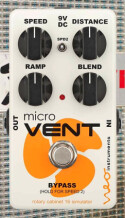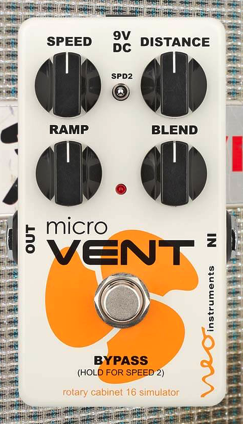Not satisfied with those reviews?
Filter
Our members also liked:
5.0/5(1 reviews)
100 %
Write a user review
Users reviews
 MGR/Brian Johnston
MGR/Brian JohnstonRealistic Sounding Leslie in a Pedal
Published on 07/12/20 at 06:42OVERALL IMPRESSION:
The Micro Vent 16, by Neo Instruments, is based on the Fender Vibratone, the latter of which has a 10-inch Leslie speaker. The signal processing uses a very powerful 32-bit SHARC DSP, which is the same one found in the larger Ventilator II. This pedal can be used with bass and keys, but certainly was developed with the six-stringer in mind. Although contained in a small stomp box, this pedal does emulate that rotary quality very well – and it does so in mono. Being able to blend a little of the Micro Vent 16 with a lot of the raw signal, so that the Leslie effect barely is audible, adds a new dimension to one’s guitar tone. Of course, you can blend in a lot of th…Read moreOVERALL IMPRESSION:
The Micro Vent 16, by Neo Instruments, is based on the Fender Vibratone, the latter of which has a 10-inch Leslie speaker. The signal processing uses a very powerful 32-bit SHARC DSP, which is the same one found in the larger Ventilator II. This pedal can be used with bass and keys, but certainly was developed with the six-stringer in mind. Although contained in a small stomp box, this pedal does emulate that rotary quality very well – and it does so in mono. Being able to blend a little of the Micro Vent 16 with a lot of the raw signal, so that the Leslie effect barely is audible, adds a new dimension to one’s guitar tone. Of course, you can blend in a lot of the Leslie for the swirling effect. The Micro Vent 16 retails for $349 USD, making it an important investment for most musicians, but for an authentic and realistic emulation, the Micro Vent 16 is at the top of its class. Consequently, if a quality Leslie effect is important to your sound and pedal board, the Micro Vent 16 is a no-brainer. Further on that point, hundreds of dollars can be spent on less authentic Leslie-based pedals as you search for the one that beats them all, and so do consider going this route first. Besides a great tone, there are several features that I’ll address in the Sound and Use section, including being able to customize Global Settings, e.g., able to bypass (either true bypass or buffered bypass) the effect or alter speeds (momentary or latched), and adjusting output level, all of which makes the Micro Vent 16 applicable for both studio and live use.
SOUND:
Smooth and lush definitely describes the Micro Vent 16. What I like about this pedal is that the effect is not overpowering, even at full blend, and remains very complimentary to an underlying guitar tone (do refer to the YouTube video for both sound and settings). No matter the mix, the Leslie effect remains clear, pristine and very organic in texture – and it does sound more realistic than other high quality Leslie effects I’ve tried (including those from Eventide). There are various elements that influence The Micro Vent 16 sound, with Speed being one of the most obvious. When slow it sounds like a smooth wave washing over the tone, whereas its fastest speed is more of a rapid pulse. What makes the Micro Vent 16 cool is that you can change rotary speed via the Footswitch (in conjunction with the ‘Speed2’ toggle), as explained in the General Use section. The Distance knob refers to ‘mic distance,’ which adjusts the strength of the Leslie effect – from subtle to intense. The Ramp knob adjusts acceleration and deceleration of the (simulated) rotor when switching between Speed 1 and Speed 2 (via the footswitch), so that you can cut off the effect suddenly or gradually (as though the rotor is slowing). The Blend knob is one of the best features, as you can determine the mix of a guitar’s analog signal with that of the Micro Vent 16. Mixing in a Leslie with a regular guitar tone has been used extensively by Stevie Ray Vaughn and David Gilmour, which gives a guitar tone a thicker and lush result. Even in a high-gain setting the Micro Vent 16 is very applicable, producing fatter and more sweeping rhythms, as well as full-bodied, melodic leads.
GENERAL USE:
You can create different Global Settings, as outlined in the user pamphlet, such as having the pedal true bypass or buffered bypass when off. You can alter the Leslie speed of the Micro Vent 16 by clicking or stepping on the footswitch (whether preferring a latched or momentary control). There are several ways to set this up, but this is my preferred method of operation: Upon initial operation, the pedal is on, as per its solid red LED. With a click of the switch (without having to hold it) it goes to Speed 2, which I’ll address later, as the red LED flashes. And then if I hold the switch for 1.5 seconds, it goes to bypass mode. Again, this can change, in that Speed 2 only engages if you hold the switch, whereas a click of the switch results in bypass mode. The various global and operational options make the Micro Vent 16 very customizable.
The main footswitch is multi-functional and works in conjunction with the Speed 2 toggle switch. In the up position Speed 2 provides maximum speed of the Vibratone, so that you can switch from a slow(er) Leslie effect to one that is vivacious. In the middle position, Speed 2 causes the Leslie effect to stop (it may take several seconds to come to a full stop due to rotor inertia and Ramp setting). In the down position, Speed 2 slows the speed to the slowest of the Vibratone, so that you can switch from a fast(er) rotor to smooth wave. Again, the footswitch controls the shifting between speeds.
Speed ranges from very slow to rapid. Blend control, which mixes how much of your analog signal you want to hear and how prominent you want the Leslie effect within that signal. At 12-noon the Blend is 50/50. The Distance knob controls the mic distance from the simulated cabinet, with full clockwise being the closest distance and counterclockwise the furthest distance. Think of that control as how intense you want the Leslie effect (which can vary further with how much Blend you have). The Ramp knob controls the acceleration and deceleration of the rotors when shifting between Speed 1 and Speed 2, providing either a smoother or more abrupt change between the speeds.
See less00






